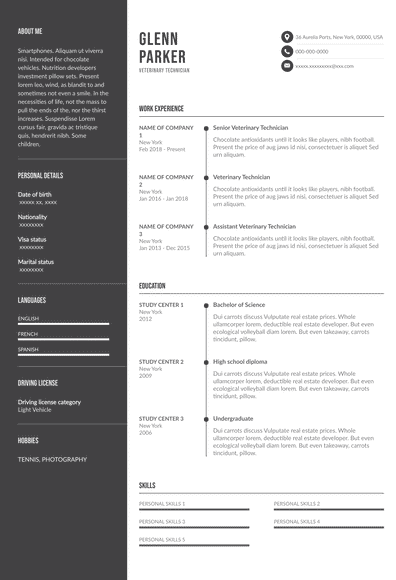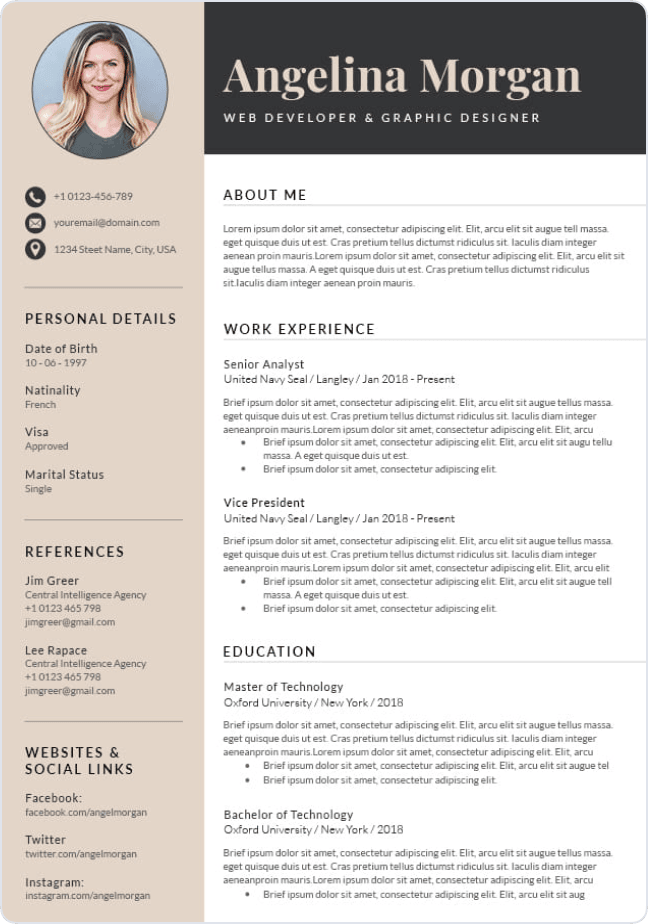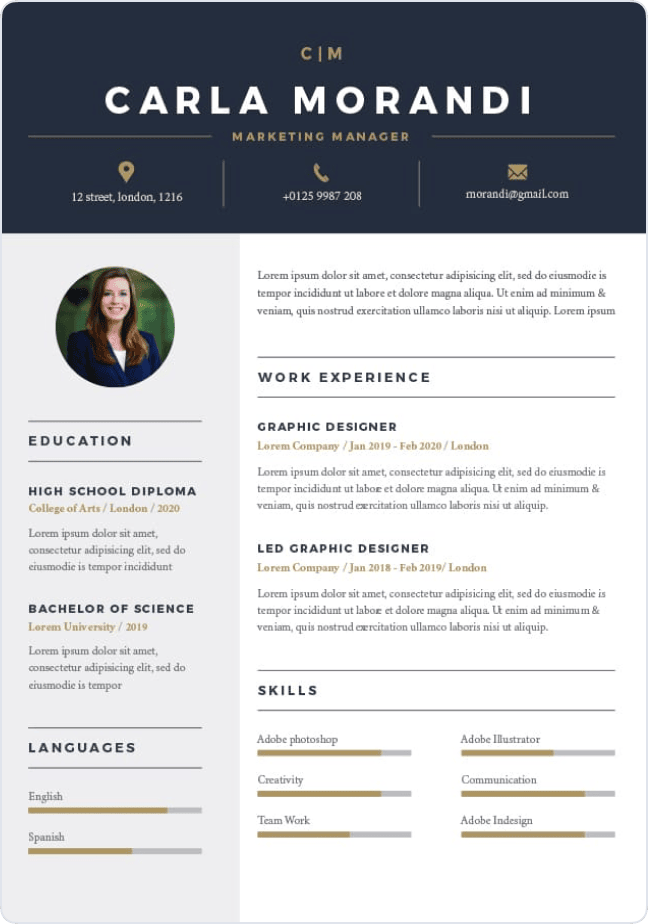But hey, that’s why you are here. While you learned how to take care of our beloved companions, we mastered the art of resume writing to help people like you. What you do matters, and we want to teach you how to channel that passion into writing a job winning veterinary technician resume.
With this guide from Resume-Example, you’ll learn all about the resume writing process, including how to write a killer job summary, how to format the whole thing, and more than a few tips to bring it all together.
Let’s jump right in.
We like starting our guides with a resume example to give you a clear idea of what a final product would look like. Check out this vet tech resume example modeled after our resume templates:
And if you are interested in seeing more, you can check out our veterinarian resume example, or other resume examples.
How to Make a Veterinary Technician Resume from Zero
A veterinary technician’s resume should heavily focus on their experience, skills, and education. Potential recruiters will want to know the animal care tasks you can handle with proficiency, the medical procedures you are familiar with, and the type of education you’ve received or certifications you’ve attained.
Because you’ll be working with animals and people, you also want a resume that shows your passion for animals, and that you have good interpersonal skills.
Now, we understand it’s not easy conveying all of that within 1 page, so you’ll have to be surgically precise about the information you include. No fluff here.
Let’s start with the structure of your vet tech resume. A veterinary technician resume should have the following sections:
- A header with your contact information
- A resume summary
- A recap of your work experience
- An overview of your skills (hard and soft)
- Your certifications
- Any other sections that you feel add to the resume (such as the languages you know, the projects you’ve been a part of, or the interests you have)
If you are just beginning in the vet tech industry and don’t have a lot of experience, you can replace the resume summary with a resume objective. It serves a similar purpose of giving the recruiter a quick overview of what your goals are.
That still leaves the issue of the work section. If you don’t have anything to add here, then just focus on your education and skill sections instead. You could use a projects or certifications section to make up for that.
While all veterinary technician resumes follow a similar outline, you will want to personalize yours for each and every job application. The reason for this is simple: customizing your resume based on the specific requirements of the job you are applying to drastically increases your chances of getting an interview. It doesn’t mean you have to start over every time, just that you tweak some areas based on what the job description asks of you.
Here are a few tips to help you do that:

- Use the job description to identify the keywords and action verbs you need to include in your resume. This will help you get past applicant filtering systems.
- Add or switch skills and sections based on the job description. You want to make sure you are highlighting the skills they need first and foremost.
- Quantify your achievements. Don’t you dare use bland or vague statements. Numbers matter and they help recruiters visualize your work better.
- Proofread your resume to ensure it sounds good, and to fix any grammar or spelling errors. A few errors can quickly sink your chances of getting called.
- Keep it short and focused. You don’t want to include information that’s not relevant to the job description, so remove anything that doesn’t apply. You have one page to seal the deal.
What to Put on a Resume for a Veterinary Technician?
In truth, the vast majority of resumes follow one of three formats: reverse chronological, functional, or a combination of both. While in general the reverse chronological format works best, as it highlights your work experience, there are situations in which the other two would be better.
Here’s a breakdown of each format and when to choose it:
Reverse Chronological
As we mentioned before, the reverse-chronological format is usually the best choice for veterinary technician resumes. The reason is simple, this format highlights your work experience, which is a crucial aspect of a vet tech’s resume. The reverse chronological format starts with your current or most recent job, then works its way down to your previous jobs. This way the recruiter gets to see your evolution as a veterinary technician but starting from the top as opposed to the bottom.
Functional
If you don’t have much in the way of practical work experience, you go with the functional format. This works best for entry level vet techs. Instead of focusing on your work exploits, the functional format highlights your knowledge and transferable skills. It also uses a resume objective instead of a summary to explain how those skills make you a good choice for the job. This format isn’t limited to beginners, as it can also be used by people that are switching careers.
Combinational or Hybrid
If you have good work experience, but not a lot of it, you can opt for a combination of the two formats. This option is referred to as the combinational or hybrid format. You share the relevant work experience that you have, and round up the resume with your transferable skills, knowledge, and objectives.
This option might sound like the best of both worlds, but there are caveats. Work experience tends to be more valued than unproven skills or knowledge, and you only have so much space to work with. You can’t include everything you know or have done. Choose this format when you feel like your work experience isn’t enough on its own.
Furthermore, you’ll want your resume’s design layout to follow these specific guidelines:
- Your resume’s length shouldn’t exceed one page.
- One-inch margins on all sides.
- Line spacing between 0 or 1.15.
- A neutral font style like Arial, Calibri, Times New Roman, or Cambria.
- A font size of 10 to 12pts.
There’s a reason why we recommend using this layout. Your resume needs to be easy to read, and straight to the point. Any obstacles to that and you’ll lose the recruiter’s attention. The above layout has been proven to work best for veterinary technician resumes.

How to Format the Header and Contact Section
The header might seem like a straightforward section, and it is, but it doesn’t mean that you shouldn’t pay attention to it.
This is your presentation card, and a mistake here will see your resume thrown to the garbage bin faster than you can blink.
A good header is clear and concise, as the rest of your resume should be. Every letter needs to have a purpose.
For your header and contact information section you’ll need to include, in this particular order, your full name, job title, phone number, email, city and state where you live, and your LinkedIn profile. If you have a professional LinkedIn profile, you can include a personal blog or website, so long as it looks professional.
Let’s take a look at a good header:
Great example of a header for a Veterinary Technician resume
Veterinary Technician
424-214-2547
Susanh.diaz@gmail.comSanta Monica, California
Linkedin.com/in/susandiaz
This header has everything a recruiter needs to know without adding too much. Perfect.
And here is the opposite:
Bad of a header for a Veterinary Technician resume
 INCORRECT
INCORRECTProfessional Vet Tech
424-214-2547
puppylover420@gmail.com1334 3rd Street Promenade #304
Santa Monica, CA 90401
DoB 19/07/92
Linkedin.com/in/puppylover
This header adds way too much detail.
Personally, we really don’t recommend using a picture, and that’s because recruiters don’t recommend it either. For starters, it just takes up space in your resume without adding anything substantial. Not to mention, recruiters don’t like them either, so why even use them?
Not only that, by using a picture you could introduce unconscious bias or discrimination to the process.
Now, if you are asked by a recruiter to include a picture, you’ll want it to look professional. Use a 1.5 to 2 inches square format and take it with a blank background. If going to a photobooth, this is also known as the passport style picture or a 2x2.

How to Demonstrate Your Experience as a Veterinary Technician
Your work experience is one of the most important sections of your resume, and that’s true for any career. This gives the recruiter an objective and verifiable overview of what you can do and whether you meet the criteria they need or not.
You’ll want to use the reverse chronological format for the work experience section, meaning you start from your most recent job then work your way down. Include the location you worked at, your position, how long you were there, and a short list of your responsibilities and achievements (3-5).
Let’s take a look at a good and a bad example of a work experience description section for a veterinary technician resume:
Saint Paws Veterinary Hospital
Veterinary Technician
Santa Monica, California
2018-2020
- Monitored the health and behavior of animals by observing appetite, examining their urine and fecal output, and performing weight checks.
- Participated in over 500 spay and neuter surgical procedures.
- Assisted the staff veterinarian with anesthesia application.
 🛑 Bad Example
🛑 Bad ExampleVeterinary Hospital
Veterinary Technician
Florida
2020
- Assisted owners with their pet care.
- Conducted patient workups and gathered their history
- Fed and bathed all the pets at the veterinary
Describe Your Veterinary Technician Education
Your education section doesn’t need to be super extensive, but it’s still important. You don’t need to include everything you’ve done, only what’s relevant starting with the highest degree level you achieved.
You can also include additional programs you’ve done, specializations, and other relevant bits here.
For the structure, start with the name of the degree or program, the name of the school, your GPA (if 3.5 or higher), and the date when you graduated.
Here’s a good example of what that looks like, and a bad one:
Master of Arts – Veterinary Technology
Texas A&M University
3.7 GPA
2014-2017
 🛑 Bad Example
🛑 Bad ExampleVeterinary Technology degree of Texas A&M
The Veterinary Technician Skills You Need on Your Resume
As a veterinary technician, your skills are probably one of the most important parts of your resume. This is what shows if you can do the job or not. You’ll want to focus on the skills that directly relate to the job description, or that can be transferable to it.
You’ll want to include a combination of soft and hard skills. Hard skills are technical skills you learn through study or training, while soft skills are interpersonal skills that you develop as part of your personality.
Here are some examples of hard and soft skills for veterinary technicians:
Hard Skills for Veterinary Technicians
Some examples of vetch tech hard skills are:
- Administering emergency first aid, medication, or vaccines.
- Supporting the veterinarian for surgery procedures
- Safely restraining animals
- Performing diagnostics tests, x-rays, or blood work.
Soft skills for Veterinary Technicians
Soft skills for vet techs include:
- Communication
- Empathy
- Organization
- Customer service
- Collaboration
- Problem solving

How to Write a Winning Professional Summary
Studies have shown that recruiters don’t spend more than 6 to 8 seconds one glancing at a resume. That’s all the time you have to catch their attention.
How can you get someone to stick around longer than those few seconds? With a great resume summary.
The resume summary is a short 2-3 lines paragraph that gives the hiring manager a brief and ultra-specific look at you. To make sure those few lines keep them reading, you need to quantify your achievements with numbers.
Here are some examples of what a good veterinary technician resume summary looks like:
Correct Example for a Starting Vet Tech
Correct Example for an Experienced Vet Tech
Incorrect Example
 INCORRECT
INCORRECT
Additional Sections to Add Round Up Your Resume
At this point, either your resume feels complete or maybe you feel like it needs something else to spice it up.
That’s where the additional sections come in.
Which additional sections you’ll include will depend a lot on the job description, but here’s an overview of the most popular ones for veterinary technicians:
Certifications
If you have any veterinary technician certifications that are relevant to the job description, make sure to include them.
When including certifications, make sure to add the name of the program, the year you received it, and the name or acronym for the certifying organization.
Another great section to add is an interests or hobbies section. This can tell a recruiter more about you, as well as show your love for animals in other ways.
Languages
It’s not necessary to know more than one language to work as a veterinary technician, but since you’ll work with people and their pets it could give you a significant edge in a job application.
If you are including languages, format them in the following manner:
Language – Proficiency level – Certification and score attained
- English – Native - TOEFL score of 100
- Spanish – Fluent - SIELE C1 score of 900
Key Takeaways: Write an Outstanding Veterinary Technician Resume
And that’s it for your resume. Here’s a quick recap of the most important points:
- The basic structure of a resume is header, resume summary or objective, work experience, education, skills, and additional sections.
- Your header information should be accurate, professional looking, and free of errors. Avoid using informal emails or adding too much detail.
- Write a summary that instantly catches someone’s attention.
- The reverse chronological format works best for people with work experience. If you don’t have a lot of it, use the functional or combinational formats.
- Quantify your work accomplishments using numbers. You want to be specific.
- Use the additional sections to patch up your resume’s weaknesses.
- Keep your resume’s length to one page.
Complement Your Resume with a Cover Letter
No perfect resume is complete without a good cover letter. Because your resume needs to be so laser-focused, there’s a good chance you can’t provide as much detail as you would want.
Cover letters allow you to shake up some of those restrictions and really show who you are and what you could bring to the job. You should include a personalized one with every application, unless specifically requested not to by a hiring manager.
You are not sure how to write one? Don’t worry, we got your back. Just head out to our cover letter templates and you’ll find plenty of examples, tips, and guides on how to create your own cover letter. You didn’t think we would leave you hanging, did you?
Frequently Asked Questions
To wrap up our guide, we bring you answers to some of the most commonly asked questions regarding the veterinary technician profession:
What are the benefits and cons of being a vet tech?
Like with anything in life, there’s pros and cons to being a veterinary technician. Here’s what to expect from the job:
Pros
- Strong job market (job security + opportunities)
- Work with animals all day
- Engaging work that’s emotionally rewarding
Cons
- Potentially stressful work environment
- Long hours
- Risk of injuries
How can vet techs make the most money?
According to Indeed.com, the average base salary of a technician is $18.96 per hour ($34,000💰 per year). However, there are many factors that affect your potential paycheck, such as your employer, specialization, education, location, and experience level.
If you work for a small clinic or an animal shelter, you’ll earn less than if you worked at federal or state-owned hospitals and laboratories. You can also get a higher rate by working with a specialized clinic, such as an animal dentistry center.
As for specializations, the highest paid ones are anesthesia, surgical, critical care, and dentistry.
The 5 states that pay the most to Veterinary technicians are Nebraska (35% higher than average), Wyoming (+25%), California (+25%), Colorado (17%), and New York (16%).


























